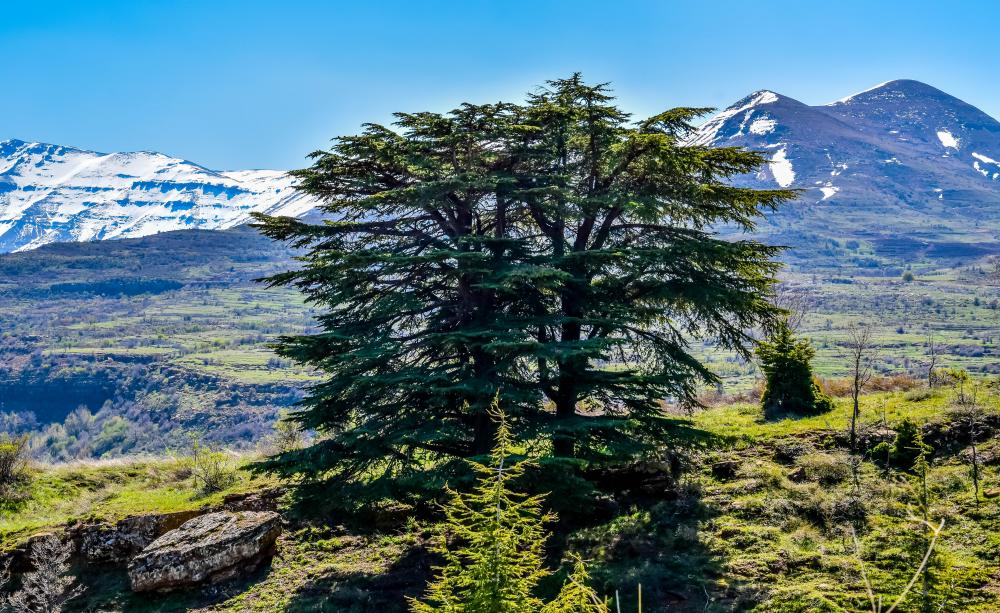-
Charbel Tawk, a Lebanese environmental activist from Bcharre, a small town in the country’s north, said: “Give a tree a holy meaning and it will be protected in a faith community”.
The Cedars of God, a forest of cedrus libani, is nestled into the mountains above Bcharre, and Maronite Christians, who make up the majority of residents in this area, believe that the cedars are holy.
Cedars are mentioned in the Bible, but reverence for the trees transcends religion and they are displayed prominently on Lebanon’s flag. Across the country, interfaith collaboration drives efforts to protect them.
Climate change
Experts forecast that by the year 2100, most of the cedars will disappear due to climate change. The trees require cold winters to reproduce, and a recent study predicted that they would only grow in three areas in Mount Lebanon by the end of the century.
Cedars thrive at altitudes between 1400 and 1500 meters, but can survive between 800 and 1800 meters, shares Charbel Tawk. The danger posed by climate change is not the first time human activity has threatened the cedars.
The Phoenicians, who lived on Lebanon’s shores, used cedar wood for their ships. Later, the Ottomans relied on the tree for railroad construction. Today, deforestation continues to threaten cedars.
In Bcharre, a group called the Friends of the Cedar Forest Committee, with whom Charbel Tawk works, have carefully stewarded over the area known as the Cedars of God since 1996. In 1998, UNESCO designated the Cedars of God, along with the nearby Qadisha Valley, as a World Heritage Site.
The Maronite Church, whose crest features a cedar tree, officially own the land, but the Committee manage conservation efforts in and around the forest. Religion is at the heart of this commitment to the cedars, says Charbel Tawk. Youssef Tawk, a doctor who is well known for his love of the cedars said: “What saved the Cedars of God was the sacred space.”
Ecosystems
The Committee spearheads an initiative to create a corridor of cedars linking Bcharre, Ehden, and Tannourine, three adjacent towns. Charbel Tawk explained: “In order to protect the forest, it’s not enough to protect it from the inside. You need to create an ecosystem.”
Planting the now barren mountains will make forests more resilient to future environmental pressures, an approach taken by other organizations throughout Lebanon. Sandra Saba, the manager of Horsh Ehden Nature Reserve, described the reforestation project as “social and biological.”
In Lebanon’s civil war, fighters loyal to Bachir Gemayel, a political leader from Bcharre, massacred Tony Frangieh, a leader from Ehden, and killed 40 others including Frangieh’s wife and young daughter. Thirty years later, tensions linger for some residents of the two towns.
Like Saba, Charbel Tawk sees the cedar corridor as an ecological and social endeavor. He said: “Nature is the easiest way to make people move closer together.” But others committed to the cedars are more skeptical.
Youssef Tawk said: “We will go, plant trees and clap, but when something happens, people are willing to pick up guns against each other. Our main preoccupations are communal and political, not environmental.”
Return to roots
In August, the Committee organized an event called “Return to Roots,” aimed at merging environmental concerns with communal ones.
Historically, Maronite Christian and Muslim communities celebrated the Festival of God together in the cedar forest near Bcharre. Charbel Tawk explained: “They came to venerate their god, and we came to venerate ours."
When the Committee took over its management in 1996, they closed the forest to the public for six years to allow for regrowth. The shared tradition ended—until the group relaunched it this past year. Elie Barakat, the current president of the Committee, said: “We are not just here to say no to the society, we are also part of it.”
Sheikh Nizam Bou Khzam, the founder of the Shouf-based Lebanese House Establishment for the Environment (LHEE), commented: “The earth is holy for all religions.” In Shouf, a region south of Bcharre, multi-confessional communities also rally behind environmental concerns. Sheikh Nizam, a Druze religious leader, founded LHEE in 1999 with the goal of organizing Lebanese from across sects to take environmental action.
The nearby Shouf biosphere reserve implements reforestation projects aimed at restoring the range of species that exist in a healthy cedar forest—from the cedars to shrubs and plants. Nizar Hani, a coordinator at the reserve, said: “Nature can be a common space for everyone.”
But he emphasized that rapid urbanization is a central challenge for both cedar forests and rural communities in Shouf. Reflecting on coexistence between himself and his Christian neighbors, Sheikh Nizam said: “When my neighbor has a problem, I help. This helps us to find a solution for environmental problems in Lebanon. Without each other, we wouldn’t know how to live.”
This Author
Catherine Cartier studies history and Arab studies at Davidson College. Her work has been featured in the New Arab, Syria Untold and Calvert Journal. She is a Beyond Religion Reporting Fellow at the Pulitzer Center on Crisis Reporting. Follow her on Twitter: @cartier_cath.
This story was produced with support from the Pulitzer Center for Crisis Reporting.
Image: Paul Saad, Flickr.





